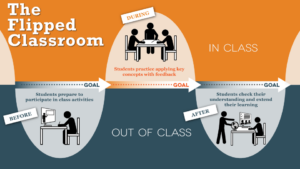Flipped learning is a transformational pedagogy for modern-day Higher Education as it turns traditional teaching methods on their head. In this approach, students are asked to engage with lecture material (interactive content, videos, readings etc.) outside the classroom, allowing students to come to class prepared with foundational knowledge, ready to delve deeper into the subject matter. Class time is then freed up for interactive, hands-on, student-centered learning activities. Examples of this include, among others, problem-solving sessions, group tasks and projects. This shift enables active learning, improves student engagement, fosters deeper understanding, and encourages critical thinking.
One significant advantage of flipped learning is its ability to accommodate diverse learning styles. Students can review course materials at their own pace. This flexibility ensures that students, regardless of their learning speed, are given a better chance to grasp the core concepts before class. Moreover, the in-class activities encourage collaborative learning, where students can learn from their peers and engage in meaningful discussions. Vygotskian zones of proximal development can also be activated, where more able peers can help out their classmates.
Flipped learning also promotes the development of higher order thinking skills and replicates the real world. During in-class sessions, instructors can pose challenging questions, facilitate debates, and present real-world scenarios that require students to apply, analyze, and synthesize information. This active learning environment not only enhances comprehension but also prepares students for professional settings where problem-solving and teamwork are crucial.
Despite its many benefits, the flipped classroom model does present challenges. It adds to the workload as it requires significant preparation from instructors to create engaging and effective pre-class materials. Additionally, it takes a lot of motivation and discipline on the students’ part to complete the preparatory work independently. However, when implemented properly, the rewards of flipped learning in higher education are substantial.
In conclusion, flipped learning is revolutionizing higher education by making the learning process more dynamic, interactive, and student-centered. This model has the potential to significantly enhance educational outcomes and better prepare students for the complexities of the modern world.

